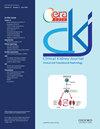Reduced renal function is associated with faster loss of bone mineral density in patients with non-dialysis CKD
IF 3.9
2区 医学
Q1 UROLOGY & NEPHROLOGY
引用次数: 0
Abstract
Background Bone mineral density (BMD) predicts fracture risk in patients with chronic kidney disease (CKD) and in the general population. However, few studies have investigated risk factors for bone loss in patients with CKD. The aim of this study was to investigate whether renal function is associated with the rate of BMD decline. Methods A prospective cohort study included 1 006 patients with CKD stages 2–4 between 2011 and 2016. BMD was measured using dual-energy X-ray absorptiometry at baseline and 4 years. The eGFR was measured 2–6 times during the 4-year follow-up. We analyzed the decline in bone mineral density according to CKD stage and further compared the rate of BMD decline according to eGFR trajectories at each stage. Results Advanced CKD stage was associated with a faster rate of decline in total hip BMD (stage 2: −0.23, stage 3A: −0.39, stage 3B: −0.80, stage 4: −1.23% change/year in men [p < 0.001]; stage 2: −0.86, stage 3A: −1.19, stage 3B: −1.20, stage 4: −1.58% change/year in women [p < 0.03]). Two distinct eGFR trajectories (Class 1: stable group; Class 2: rapid decline group) were observed. The rapid decline group showed a trend toward an increased rate of decline in total hip BMD. Subgroup analysis according to eGFR trajectories revealed a significant difference in BMD decline rate between stable and rapid decline groups. Conclusions Advanced CKD stage and accelerated decline in renal function were associated with rapid BMD decline in non-dialysis patients with CKD.肾功能减退与非透析性慢性肾功能衰竭患者骨矿物质密度流失加快有关
背景 骨矿物质密度(BMD)可预测慢性肾脏病(CKD)患者和普通人群的骨折风险。然而,很少有研究对 CKD 患者骨质流失的风险因素进行调查。本研究旨在探讨肾功能是否与 BMD 的下降速度有关。方法 一项前瞻性队列研究纳入了 2011 年至 2016 年间的 1006 名 2-4 期 CKD 患者。在基线和 4 年时使用双能 X 射线吸收测量法测量 BMD。在 4 年的随访期间,对 eGFR 进行了 2-6 次测量。我们根据 CKD 阶段分析了骨矿物质密度的下降情况,并根据每个阶段的 eGFR 轨迹进一步比较了 BMD 的下降率。结果 CKD 晚期与总髋骨矿物质密度下降速度较快有关联(2 期:-0.23,3A 期:-0.23,3B 期:-0.23):-0.23,3A 阶段-0.39,3B 阶段3B期:-0.80,4期:-1.23男性每年变化-1.23% [pamp;lt;0.001];阶段 2:-0.86,3A 阶段:-1.19,3B 阶段:-1.23-0.86,第 3A 阶段:-1.19,第 3B 阶段:-1.20,第 4 阶段:-1.23-0.86,3A 阶段:-1.19,3B 阶段:-1.20,4:女性的变化率为-1.58%/年 [pamp&;lt;0.03])。观察到两种不同的 eGFR 变化轨迹(1 级:稳定组;2 级:快速下降组)。快速下降组显示出总髋关节 BMD 下降率增加的趋势。根据 eGFR 轨迹进行的分组分析显示,稳定组和快速下降组的 BMD 下降率存在显著差异。结论 在非透析的慢性肾脏病患者中,慢性肾脏病晚期和肾功能加速衰退与 BMD 快速下降有关。
本文章由计算机程序翻译,如有差异,请以英文原文为准。
求助全文
约1分钟内获得全文
求助全文
来源期刊

Clinical Kidney Journal
Medicine-Transplantation
CiteScore
6.70
自引率
10.90%
发文量
242
审稿时长
8 weeks
期刊介绍:
About the Journal
Clinical Kidney Journal: Clinical and Translational Nephrology (ckj), an official journal of the ERA-EDTA (European Renal Association-European Dialysis and Transplant Association), is a fully open access, online only journal publishing bimonthly. The journal is an essential educational and training resource integrating clinical, translational and educational research into clinical practice. ckj aims to contribute to a translational research culture among nephrologists and kidney pathologists that helps close the gap between basic researchers and practicing clinicians and promote sorely needed innovation in the Nephrology field. All research articles in this journal have undergone peer review.
 求助内容:
求助内容: 应助结果提醒方式:
应助结果提醒方式:


